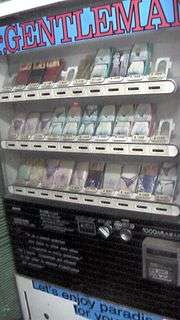Burusera

Burusera (ブルセラ) is a Japanese word, coined by combining burumā (ブルマー), meaning bloomers, as in the bottoms of gym suits, and sērā-fuku (セーラー服), meaning sailor suit, the traditional Japanese school uniforms for schoolgirls.[1][2][3] Burusera shops sell girls' used school uniforms, panties and other fetish items.
History
In the 1990s gravure magazines started to feature photos of girls wearing bloomers and school uniforms, some magazines featuring exclusively those types of clothes. Fetish shops selling these types of clothes also started appearing in Japan. Along with loose socks they became the symbol of high school girls in the 1990s. They are also sometimes worn as cosplay.
Burusera shops
Burusera shops sell used girls' gym suits and school uniforms, including Catholic school uniforms. They also sell other goods procured from schoolgirls, e.g. undergarments, school swimsuits for physical education, socks, stationery, sanitary napkins, tampons and saliva.
The clothes are often accompanied by ostensibly genuine photos of the girls wearing them. The clients are men who smell or otherwise experience the items for sexual stimulation.
Schoolgirls once openly participated in the sale of their used garments, either through burusera shops or using mobile phone sites to sell directly to clients. When laws banning the purchase of used underwear from minors were introduced in Tokyo in 2004, it was reported that some underage girls were instead allowing their clients (called kagaseya (嗅がせ屋) or sniffers) to sniff their underwear from directly between their legs.
Legal restrictions
In August 1994, a burusera shop manager who made a schoolgirl sell her used underwear was arrested by the Tokyo Metropolitan Police Department on suspicion of violation of article 34 of the Child Welfare Act and article 175 of the Criminal Code. The police alleged violations of the Secondhand Articles Dealer Act which bans the purchase of secondhand goods without authorization.[4]
Child pornography laws imposed legal control over the burusera industry in 1999.[5] However, burusera goods in themselves are not child pornography, and selling burusera goods is an easy way for schoolgirls to gain extra income. This has been viewed with suspicion as child sexual abuse.[6]
Prefectures in Japan began enforcing regulations in 2004 that restricted purchases and sales of used underwear and saliva of people under 18.[7]
References in media
- In the Shin Kimagure Orange Road novel Summer's Beginning, main character Kyosuke Kasuga is disgusted when he finds out that his now highschool-aged younger sister Kurumi intends to sell her used leotards to a burusera shop.[8]
- In the visual novel True Love, a key part to Mayumi Kamijou's route involves the Player Character, Daisuke, finding out that she intends to sell a pair of her panties in the local burusera shop. If Daisuke finds said panties, keeps them and gives them back to Mayumi when she asks him for it, he will gain relationship points with her.
- In Yandere Simulator the Player Character, Yandere-Chan, can purchase a "Dark Secret" from Info-Chan as a favor. Info-Chan sends Yandere-Chan a text saying that she has video footage of Kokona Haruka, one of Yandere-Chan's rivals, selling used panties to a boy from another school.
See also
- Clothing fetish
- Uniform fetishism
- Panty fetishism
- Shoe fetishism
- Child pornography laws in Japan
- Panchira
- Zettai ryōiki
- AV idol
- JK business
- Cosplay restaurant
- Host and hostess clubs
- Maid café
- Hentai
- Kogal
- Gyaru
References
- ↑ "The economics of pricing used panties." http://aprilsbody.com/used-panties-prices-explained/ (Retrieved on Feb. 16, 2014).
- ↑ Telegraph news report
- ↑ Sydney Morning Herald news report
- ↑ 警察白書 (Police White Paper), 1994. (in Japanese)
- ↑ 児童買春,児童ポルノに係る行為等の処罰及び児童の保護等に関する法律 (Act on Punishment of Activities Relating to Child Prostitution and Child Pornography, and the Protection of Children)
- ↑ The Ninth United Nations Congress on the Prevention of Crime and the Treatment Offenders Cairo, Egypt: A Report from the Japan Federation of Bar Associations to the Ninth United Nations Congress on the Prevention of Crime and the Treatment of Offenders, March 1995, Japan Federation of Bar Associations. Archived April 8, 2011, at the Wayback Machine.
- ↑ 東京都青少年の健全な育成に関する条例 (Tokyo Metropolitan Ordinance on Juvenile Protection) Articles 15, 15-2 and 15-3. (in Japanese)
- ↑ Shin Kimagure Orange Road: Summer's Beginning.